Why Coastal Access Is an Environmental Justice Issue
Beach access has long been shaped by multiple systemic injustices. It’s time to change that.
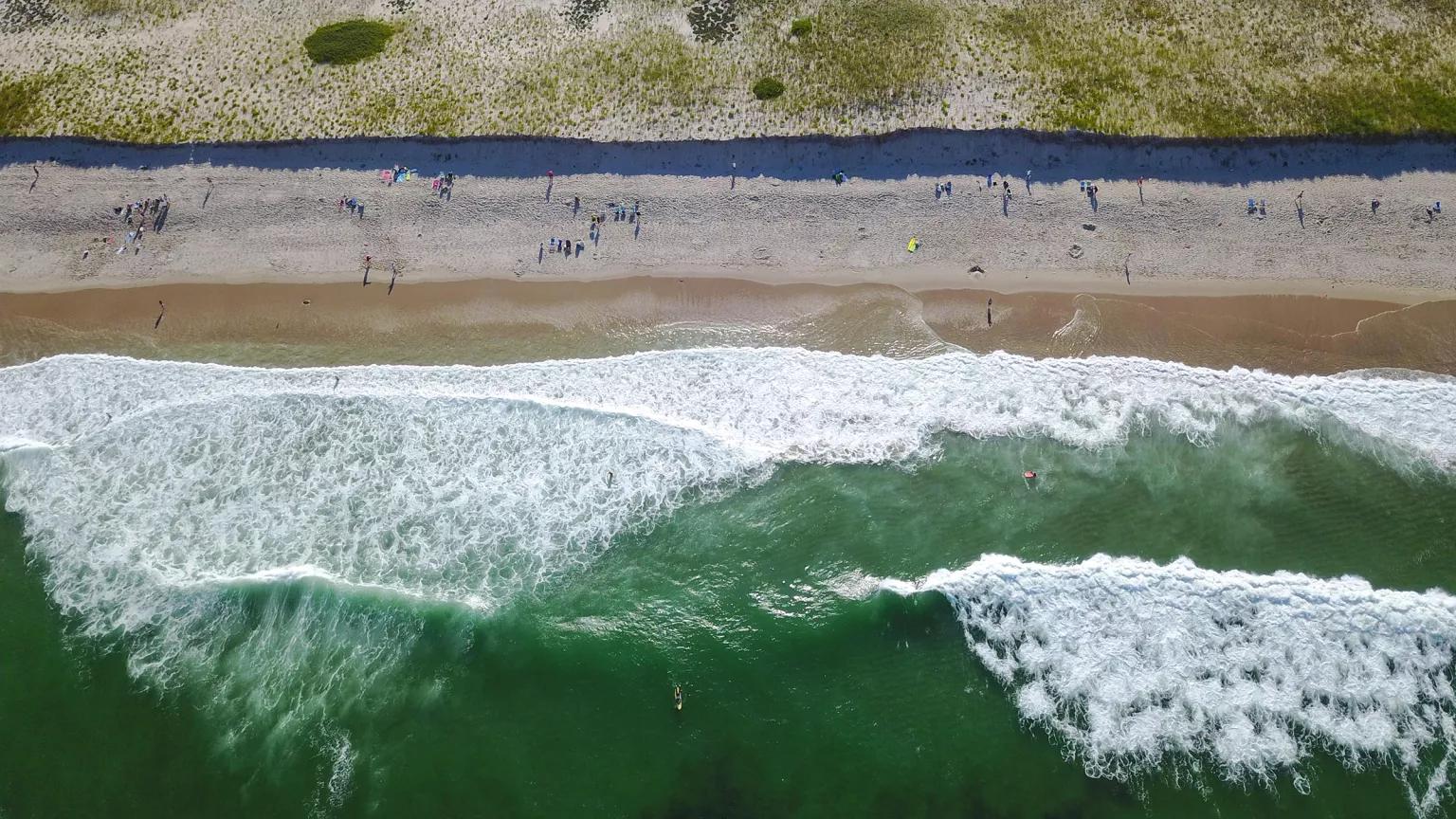
Atlantic Ocean waves wash onto Nauset Beach at Cape Cod in Massachusetts.
Ethan Daniels/Alamy
As a Boston resident of more than 20 years, I have learned the secrets that unlock a great day at the beach. So when a friend who’s new to town asked me where to go to enjoy the coast, I was happy to relay a long list of complicated instructions. My advice included tips like applying for lottery reservation spots, arriving at beach parking lots at 6 a.m., and kayaking through estuaries and salt ponds to ultimately land a sandy square on a coveted piece of Massachusetts shoreline. Her look of confusion reminded me that getting to the beach should not be this difficult.
Though Massachusetts boasts more than 1,400 miles of coastline, only about 170 miles (just 12 percent) are truly accessible to the public. Coastal towns control more than 35 percent of the state beachfront and vigilantly enforce residents-only access through measures that include parking limitations and walk-on passes. Private landowners control an additional 27 percent and the remaining 26 percent are cut off by natural barriers. Beachgoers without this elite entrée to private or semiprivate coastlines are subject to a “feet-in-water” policy. That means that on these beaches, the public only has the right to navigate, bird-watch, or fish between the low and high tide marks and may not “casually stroll.” Massachusetts is one of only four states in which coastal public easements don’t extend to the high tide line.
The discrepancy comes down to how each state implements the public trust doctrine, a legal principle that holds that certain natural resources belong to all people. First codified by the Roman Empire, it stated: “By the law of nature, these things are common to all mankind—the air, running water, the sea, and consequently, the shores of the sea. No one, therefore, is forbidden to approach the seashore.”
Yet Massachusetts’s management of the doctrine, which dates back to the 1600s, is just one example of how inaccessible some U.S. coastal areas can still be. In fact, a recent report from the Center for American Progress and the Hispanic Access Foundation found that strong legal protections ensure equitable public access to only 10 percent of the U.S. coast and Great Lakes.
Such inequities stem from, and are perpetuated by, systems of racial injustice. But there are a growing number of solutions. Progress is being made at the grassroots level, where leaders within marginalized groups are working to build community and transform coastal culture (sometimes, one surfer at a time), and at the policy level, where equitable coastal access is being prioritized as part of climate adaptation plans and in the stewardship of our blue spaces.
The historical inequities that shaped coastal access
It’s no accident that coastal communities in the United States are predominantly white. Racist and exclusionary laws, policies, and practices kept many beaches, even public ones, off-limits to people of color through the 1970s. The long-lasting impacts of those historical injustices—racial segregation, housing covenants, and redlining, to name a few—continue to inhibit the ability of millions of people of color to enjoy what should be public spaces.
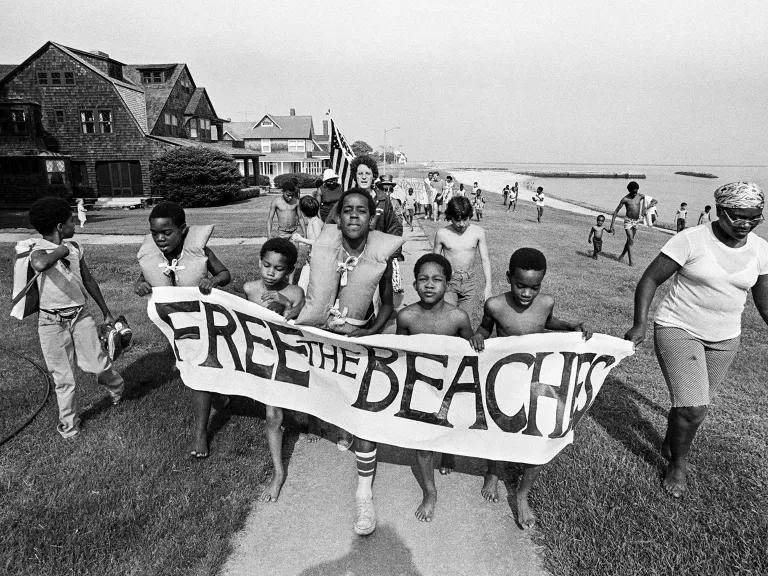
Young members of the Revitalization Corps volunteer organization marching for public beach access in Old Saybrook, Connecticut, in the 1970s.
Bob Adelman
Within many coastal towns in the early 20th century, homeowners, neighborhood associations, and real estate companies agreed to racially restrictive housing covenants. These are clauses within property deeds that barred the sale of homes to BIPOC buyers. By limiting beaches to residents, the towns reserved them for, well, their white residents. Commonplace across the country, such covenants went hand in hand with redlining, a racist federal housing policy, in place from the 1930s to the late ’60s that prevented home buyers in or near communities of color from acquiring mortgages. Taken together, even if a Black family found someone willing to sell them a home, getting the loan necessary to buy it would be near impossible.
Meanwhile, Black beach communities often saw their desirable lands stolen from them. There are notable examples of government seizures of Black-owned coastal land in places such as Hampton in Virginia, Hilton Head in South Carolina, Kiawah Island in Georgia, and Manhattan Beach in California. In his book, The Land Was Ours: African American Beaches from Jim Crow to the Sunbelt South, historian Andrew Kahrl notes:
“The shores that African Americans steadily lost over the course of the second half of the twentieth century…demonstrate the inextricability of environmental and human exploitation—power over lands and power over persons—and force us to reassess the familiar story of America’s triumph over segregation, its achievement of civil rights, and its slow, painful but nevertheless inexorable progress toward a more just and equitable future.”
Many Southern cities, such as Charleston, South Carolina, and Miami, overtly prohibited Black people from most public beaches. And while swimming areas for Black communities did exist, they were few, hard won, often remote, polluted, or otherwise hazardous. For example, in 1939, the Orleans Parish Levee Board designated one such site on Lake Pontchartrain, which was located 12 miles from downtown and not served by public transportation. The beach was also adjacent to fish camps that dumped raw sewage into the water.
With coastal communities being racially exclusive by design, white terrorism throughout the 1900s served as a means to reinforce this pattern of restriction through fear and brutality. In 1919, a white man on the shores of Lake Michigan in Chicago threw stones at Eugene Williams, a Black teenager whose raft had accidentally drifted across a perceived color line in the water, causing the boy to drown. The murder, and subsequent refusal of a white police officer to arrest the man, sparked a weeklong riot that left 37 others dead and the homes of an estimated 1,000 Black families destroyed. And, as late as 1975, when Black protesters attempted to peacefully desegregate a de facto whites-only beach in Boston, a riot ensued after white residents began throwing bottles and rocks.
The ongoing impacts of restrictive beach access
The effects of historic racism, as well as ongoing systemic racism, continue to uphold barriers to coastal access. Among the most obvious are those that are financial and cultural in nature. Even in states with strong legal access protections, such as California and Oregon, getting to the beach can be challenging for the general public, especially for low-income households and communities of color. In Los Angeles County, public transportation, expensive parking, and a lack of affordable overnight lodging present serious hurdles. And throughout California, permits for organizations running water-related programs are limited, making it difficult to create culturally specific options for marginalized groups. If people manage to get to a beach, there are countless instances of landowners with properties abutting public lands, illegally obstructing ingress points and harassing or intimidating members of the public. In fact, a 2022 poll of U.S. Latino voters found that more than 42 percent of respondents said that they sometimes feel unwelcomed and experience hostility when visiting coastal areas.
The inability to recreate on the coast, of course, has consequences that extend beyond an individual’s fundamental right to this natural resource. Data suggests that time spent near the ocean is positively correlated with better physical and mental health, since blue spaces promote physical activity, social interaction, and relief from anxiety and stress.
But perhaps the most alarming outcome is the great disparity in drowning rates among the country’s white and BIPOC populations. The Centers for Disease Control and Prevention's most recent data for those aged 29 and younger show that Indigenous people drown at twice, and Black people 1.5 times, the rate of white people. In order to save lives, the researchers recommend public health policies that promote more equitable access to pools and beaches, and thus, more exposure to swimming lessons and water safety training.
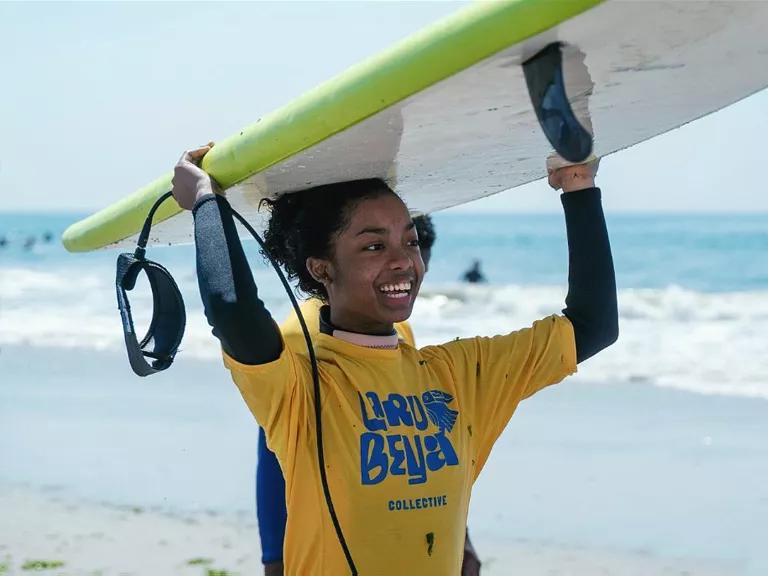
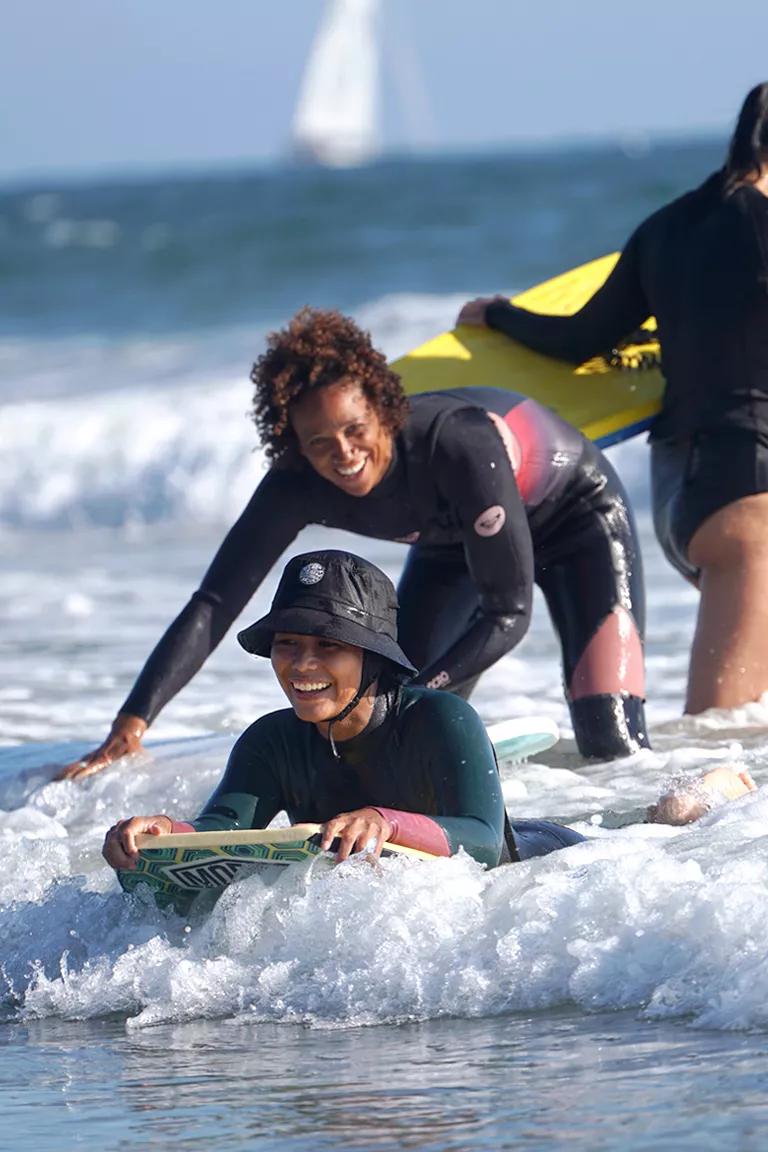
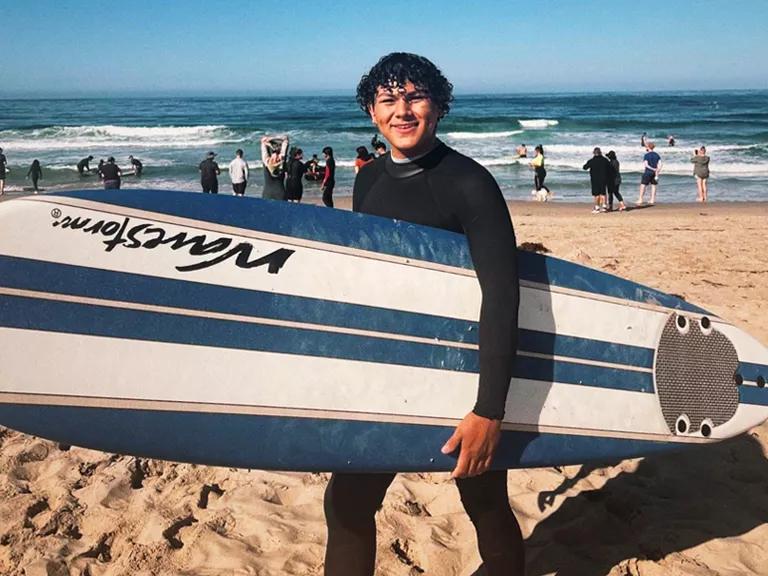
Clockwise, from top left: A Laru Beya Collective surfer prepares to hit the waves; Color the Water members participating in BIPOC Surf Therapy programming; Axel Perez enjoying Los Courage Camps’ all-boys surf day
Laru Beya Collective
; 2)Color the Water
; 3)Los Courage Camps
How BIPOC-led organizations are reclaiming the coast
Blue spaces that center Black people are one way that communities have sought to rectify the injustices caused by racial exclusion. Historically, Black beaches—such as the Inkwell on Martha’s Vineyard, American Beach near Jacksonville, Florida, and Idlewild, a lake beach in Michigan—offered Black locals freedom to enjoy the water without facing racial hostility. Many of these beaches continue this important legacy today; in other regions, events such as those held by Los Angeles’s Ebony Beach Club provide space for cultural belonging.
And around the country, what look like surf groups or simple social gatherings at first glance are, in fact, BIPOC-led efforts to build community in and around the water. Within these spaces, individuals and families have an opportunity to learn to swim, surf, sail, and more in a setting where they can feel safer. Such affinity groups include Brown Girl Surf and Color the Water in California, Colorful Lineup in Rhode Island, Laru Beya Collective in New York City, and Surfear Negra in Florida.
In 2017, Giselle Carrillo founded Los Courage Camps to bring Latine children from their neighborhoods around Los Angeles to the beach for free surf lessons and to ground them in their courage—what she defines as “the emotion that sits between fear and hope.” Carrillo believes that ocean access is critical to bringing balance back to communities facing poverty, violence, and inadequate education systems. “People are coming from as far as 22 miles east of the coast,” she says. “We’re stacking on positive associations with the beach and showing them that we can come as we are.” One of Carrillo’s proudest moments was when she heard that, on the first day of school, one of her six-year-old participants introduced herself to the class as a dancer and a surfer. “I didn’t know any Latino surfers as a kid, and I didn’t envision it for myself,” she says, “[but] data show that the quality of life of those who have ocean access is much better than those who do not.”
What can be done to begin to right coastal inequality
Today, climate change threatens all coastal areas. As a result, the often majority-white communities lining the coasts in the United States receive public funding at the municipal, state, and federal levels to mitigate the damage from sea level rise, shoreline erosion, and the impacts of more frequent and more severe storms. This presents a practical opportunity to promote coastal equity by requiring communities that apply for such funding to include, in their planning, strong protections for public access to the shore and ocean. Several states already have such explicit conditions for public funding. The federal government could likewise adopt similar requirements that ensure public dollars, like those from the Inflation Reduction Act and the Bipartisan Infrastructure Law, benefit everyone. “It’s critical that we connect people to nature,” says NRDC ocean advocate Anupa Asokan. “It’s healthy for communities, and it increases commitment to stewardship of the places we are trying to protect.”
There are also numerous other ways government policies can support equitable coastal access. Marine protected areas (MPAs) are one. The United States has almost 1,700 MPAs, and many lie in the waters right off the coasts of state parks. This proximity allows for collaborations in public education and could open up additional coastlines adjacent to the state parks, which would improve accessibility for all recreationists. New national marine sanctuaries, which include increased public beach access in their mandates, are another. The proposed Chumash Heritage National Marine Sanctuary offers such a huge opportunity for this. The initiative, led by the Northern Chumash Tribal Council, would link together 134 miles of central California coastline. The current draft plan for the sanctuary calls for “substantive involvement” of all interested local Indigenous communities. This would help ensure that the first stewards of these lands and waters are part of the management of them and that they can continue their cultural activities within the sanctuary.
In addition to dealing with so many obstacles to enjoying the nation’s shorelines, people of color and low-income communities have to contend with a disproportionate amount of the environmental degradation of our coasts. This includes industrial pollution as well as climate change impacts, such as sea level rise and the devastation left by fiercer, and more frequent, storms. In recognition of this fact, 18 advocacy groups, including NRDC, have come together to form the Ocean Justice Forum. The consortium seeks to address and prevent inequities in ocean policy—anything from improving disaster response to promoting a just ocean economy to delivering “equal access to healthy and prospering shorelines and oceans for all.” For those who have experienced the inequity of access, this is a welcome vision that we must work together to enact.
This NRDC.org story is available for online republication by news media outlets or nonprofits under these conditions: The writer(s) must be credited with a byline; you must note prominently that the story was originally published by NRDC.org and link to the original; the story cannot be edited (beyond simple things such as grammar); you can’t resell the story in any form or grant republishing rights to other outlets; you can’t republish our material wholesale or automatically—you need to select stories individually; you can’t republish the photos or graphics on our site without specific permission; you should drop us a note to let us know when you’ve used one of our stories.
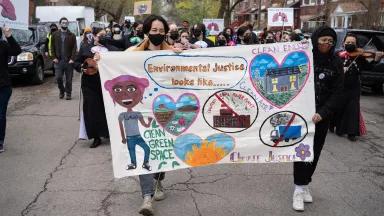
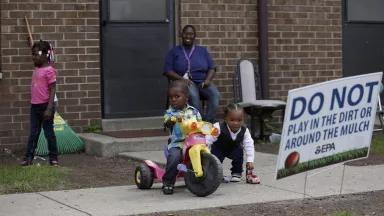
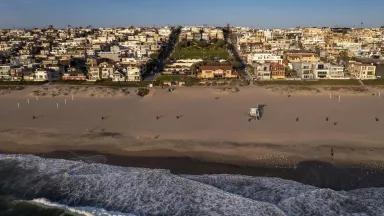
This Is How We Stand Up to Trump
What We Learned from the BP Oil Disaster
Should I Become a Poll Worker?